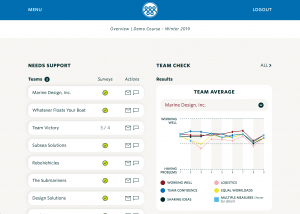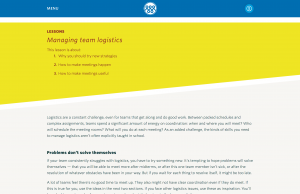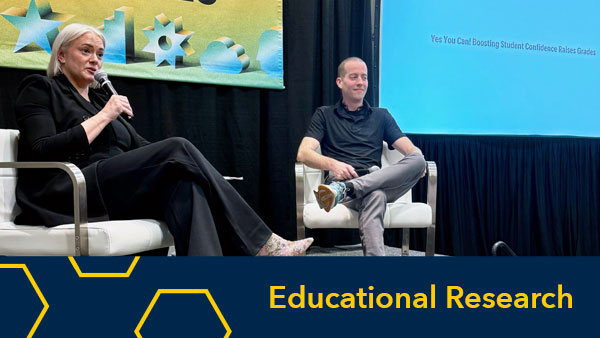Robin Fowler, Lecturer, Technical Communication Program, College of Engineering
Laura Alford, Lecturer in Naval Architecture and Marine Engineering, College of Engineering
Stephanie Sheffield, Lecturer, Technical Communication Program, College of Engineering
We’ve been teaching a team-based introductory engineering course together for ten years, and we’re aware that students aren’t always excited to receive group assignments. In our course, we developed a set of team support interventions that addressed several student concerns:
- we asked students to assess themselves and each other at multiple time points
- we gave explicit instruction in team norms as well as problematic patterns that occur in student teams and in the workplace
- we asked teams to develop a shared set of norms as a formal agreement
- we asked students to regularly reflect on their own role and their team functioning
All of this instructional time and the effort to collate and act on this information happened in addition to the engineering and communication instruction students were supposed to get as part of the course. We were burned out, yet our efforts to support our teams still weren’t always enough.
Therefore, we approached the Office of Academic Innovation… and now we’re working with them to make a tool to support student teams! We’re excited to describe the origins of this tool—Tandem.
We aren’t entrepreneurs or founders of a startup. We are instructors and teacher-researchers, considering how technology can do the following:
- help teams work together better
- mediate equity concerns inherent in group projects
- teach explicit teamwork lessons that students see as relevant
Why teams must be supported
While research suggests team-based pedagogies have the potential to increase student learning, motivation, and even degree completion, teamwork sans instructor support can actually negatively impact students. Teams sometimes struggle to share work equitably, and student complaints often center on non-participatory teammates (called social loafers in the literature). Students, especially early in their careers, often struggle with project management and team logistics. Because of these challenges, it’s really important that instructors support teams to create positive team experiences— we don’t want negative experiences on teams to affect students’ sense of competency and belonging in the discipline.

Many team issues that occur in adult teams in the workforce are especially pronounced in student teamwork. For example, our socialization affects how we speak up (or choose not to) in large conversations and determines who is heard in those conversations. Our biases affect who we assume is capable of particular types of tasks, and who we trust to be responsible teammates.
What happens on teams is really, really important. Those of us who are concerned about inclusive teaching and ensuring equitable student experiences in our classes know team dynamics are ‘outside of our control,’ but have critical ramifications. Research has shown various potential implications — unequal task allotment affects who receives mastery experiences in a class; group conversations privilege particular types of conversationalists; and impressions of the ‘expertise’ of teammates affect who leaves the course with an enhanced sense of belonging in the discipline.
Teaching students to be good team members is more than just ‘teaching them to be good humans.’ Several work patterns common to successful students are not conducive to successful teamwork, such as working to a deadline. Negative team experiences can also happen due to decisions team members make below the level of conscious awareness, like who speaks up and is heard in group meetings.
There are textbooks to ‘teach’ teamwork that address some of these teaming issues, and we’ve experimented with external readings, an interactive teamwork sketch, and discussions of team behaviors in the class. While we were able to select topics we knew were relevant for many of our students, this instruction was always adopted at the level of the class, and it didn’t reflect the specific issues that each individual team was facing.
In the past, we settled on a system of instruction plus reflection; students read short pieces about team experiences and then reflected on how the ideas from the reading explained team experiences or could influence them going forward. We adopted this system of reflection because it works for learning a skill like teamwork. While explicit teaching of teamwork might help students be aware of and identify the benefits of various collaboration channels, much about learning to be a good team member requires experiential learning. Research on experiential learning emphasizes the importance of formative feedback and reflection, but providing individualized feedback and the opportunity for reflection — at scale — is very difficult.
Similarly, there are methods of assessing students as team members, and these tools can be used formatively or summatively. Note that using them formatively and well isn’t a light lift — while you can sometimes click a ‘release to students’ button, the information is provided to students without scaffolding; it’s unclear how exactly students should use it. However, even summative feedback seems to lead to gains, as students are able to use that feedback formatively for their next team endeavors.
Most peer assessments we’re aware of are agnostic to equity issues that might occur on teams. It’s hard to detect a rigged system without systematic collection of an abundance of intentional data. In her book “What Works: Gender Equality by Design”, Iris Bohnet encourages faculty to address equity concerns by “collect[ing] data to understand whether and why there is… inequality; experiment[ing] with what might close… gaps; and informed by behavioral insights to create signposts, nudg[ing] behavior toward more equality.” For example, imagine you have a class in which the students wearing blue shirts spoke half as much as students wearing other colored shirts in team meetings. You’d want to think about whether that’s a concern (maybe it’s not) and how you could offer other opportunities to participate. But you can’t even begin to think about how to respond without noticing in the first place that there’s a relationship between blue shirts and participation.
Supporting teams, especially with these equity issues, is really difficult. Tandem can make it easier.
Noticing those patterns in teams is difficult or impossible, especially if your team assessments happen in different mediums and data are in various locations (like when we did our peer assessments using a popular online tool, our reflections in Canvas, and our team meetings in person).

We realized a tool could help identify these patterns, if we designed it right; thus Tandem was born, designed with behavioral scientists, developers, and user experience designers from Academic Innovation. With Academic Innovation’s support, three courses will implement the tool in Fall 2019.
We look forward to making a publicly-available app soon to support more users, since we can currently only support a small number of users while the tool is a research project. When a class agrees to use Tandem, our team works with them to design a custom version for their context, which allows us to study their experience in adopting it.
No app will magically fix all issues surrounding team-based learning. But our aim is that Tandem will help instructors better support their students by improving teamwork experiences and encouraging equity. Going forward, we’ll investigate the experiences of students on teams supported by Tandem and on teams not supported by Tandem to see whether the tool can improve students’ experiences on teams and their knowledge about teamwork.


